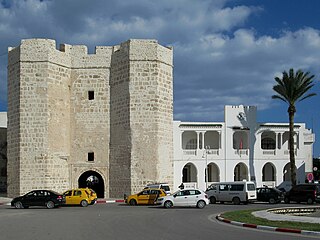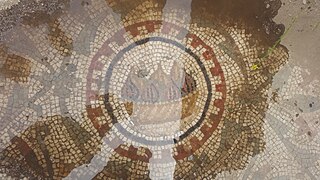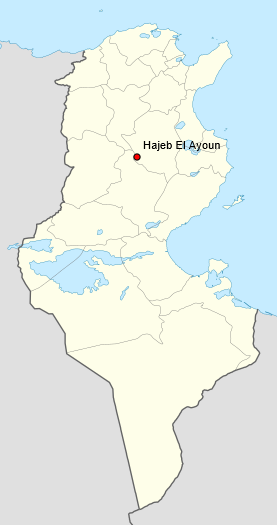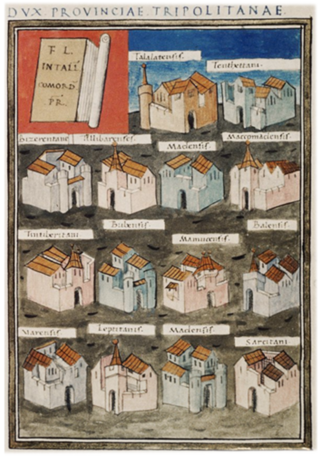Related Research Articles

Mahdia is a Tunisian coastal city with 62,189 inhabitants, south of Monastir and southeast of Sousse.

Byzacena was a Late Roman province in the central part of Roman North Africa, which is now roughly Tunisia, split off from Africa Proconsularis.

Furnos was the name of two towns and bishoprics in the Roman province of Proconsular Africa. They are referred to as Furnos Maior and Furnos Minor, as now as separate Latin Catholic titular sees.
Dometiopolis was a city of Cilicia Trachea, and in the later Roman province of Isauria in Asia Minor. Its ruins are found in the village of Katranlı, Ermenek, Karaman Province, Turkey.
Augustamnica (Latin) or Augoustamnike (Greek) was a Roman province of Egypt created during the 5th century and was part of the Diocese of Oriens first and then of the Diocese of Egypt, until the Muslim conquest of Egypt in the 640s.

Hajeb El Ayoun is a town and commune in the Kairouan Governorate, Tunisia. As of 2004 it had a population of 9,648. It is also the capital of a district of 35,403 inhabitants.
Jebiniana is a town and commune in the Sfax Governorate, Tunisia.
Beniane is a town and commune in Mascara Province, Algeria at the site of ancient Ala Miliaria, a former bishopric which earns a Latin Catholic titular see.

Girus Tarasii was a town in the Roman province of Numidia that became a residential episcopal see. It is tentatively identified with ruins situated at what is now called Henchir-Tarsa in Algeria.

Aggar was a town and bishopric in the Roman province of Byzacena. One of two cities in the area, it left vast ruins that are now called (Henchir) Sidi Amara. These edifices are situated in the plain of Siliana, around 60 kilometres east of Maktar.

Nisa, also Nyssa (Νύσσα) or Nysa (Νύσα) or Neisa (Νείσα), was a town in ancient Lycia near the source of the River Xanthus.
Aquae Novae in Proconsulari is a former Ancient city and bishopric in Roman Africa and present Latin Catholic titular see.

Aquae in Proconsulari is a former Ancient city and bishopric in Roman Africa and present Latin Catholic titular see.

The Titular Bishopric of Vita (Vitensis) was a Roman–Berber civitas in Africa Proconsularis. It is a former Christian diocese and Latin Catholic titular see. The name 'Vita' means life.
Furni, also known as a Furnos Maius and Ain-Fourna, was a Roman era civitas of the Roman province of Africa Proconsularis on the Oued Kibira tributary of the Meliane River.
Limnae (in Pisidia) was a city and bishopric in the Roman province of Pisidia (Asia Minor), which is now a Latin Catholic titular see.

The Diocese of Aquensis in Byzacena is a home suppressed and titular see of the Roman Catholic Church.
Gunugus or Gunugu was a Berber and Carthaginian town in northwest Africa in antiquity. It passed into Roman control during the Punic Wars and was the site of a colony of veteran soldiers. It survived the Vandals and Byzantines but was destroyed during the Muslim invasion of the area.

Thimida Regia is a former Roman city of the Roman province of Byzacena in North Africa. The town was the episcopal see of an ancient Christian diocese which flourished until the arrival of Arab armies in the 640s. That diocese survives today only as a Latin Church titular see of the Catholic Church, and has effectively ceased to function. The current bishop is Florencio Armando Colín Cruz of Mexico.

Tripolitania was a province of the Roman Empire. Between the 2nd century BC and the 3rd century AD it had been known as Syrtica; in the 3rd century it was renamed Tripolitania meaning "region of the three cities", referring to Oea, Sabratha and Leptis Magna.
References
- ↑ R. B. Hitchner Urusi at Pleiades: A Gazetteer of Past Places (2012).
- ↑ R. Cagnat and A. Merlin, Atlas archéologique de la Tunisie (1:100, 000), (Paris, 1914–32). p.30.10
- ↑ Barrington Atlas: BAtlas 33 E1.
- ↑ Victor of Vita, History of the persecution by the Vandals, I, 3.
- ↑ Annuario Pontificio 2013 (Libreria Editrice Vaticana, 2013, ISBN 978-88-209-9070-1), "Sedi titolari", pp. 819-1013
- ↑ "Titular Episcopal See of Urusi". GCatholic.org. Retrieved 25 June 2015.